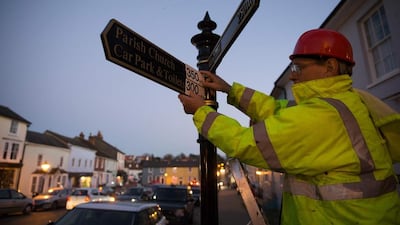HUNTINGDON // Armed with high-vis jackets, a ladder and a half-inch spanner, Tony Bennett and Derek Norman are the footsoldiers of Brexit, waging a slow but successful battle against the metric system, one street at a time.
As the setting sun casts an orange glow on the high street in Thaxted, a small town in south-east England, Mr Bennett carefully sticks a plastic card onto a street sign so it gives distances in yards, not metres.
“They were such nice signs, it was a shame to alter them,” says Mr Norman, the 82-year-old chairman of the Active Resistance to Metrication (Arm) activist group.
Speaking at his home in Huntingdon, eastern England, after the Thaxted “job”, he says imperial measurements are “part of our culture” and need defending.
Britain first began introducing the metric system in the 1960s, and the move was accelerated by the need to harmonise measurements across the European Union.
But the government has stepped back from ditching imperial measures altogether due to public opposition driven by activists like Mr Norman and Mr Bennett, who are both supporters of the anti-EU UK Independence Party.
READ MORE: Could Italy’s referendum deliver a Brexit and Trump-style shock?
Today, most public businesses and packaged foods in the UK use metric units, while traffic signs are in miles and yards, and beer, cider and milk are sold in pints.
Amid the confusion, some local authorities and businesses continue to install signs in metres – which Mr Norman and Mr Bennett, Arm’s secretary, feel they have a duty to amend.
“When we took down the first sign my heart was beating in fear that we would be arrested,” says Mr Bennett. “After you do it a few times, you lose the fear.”
They believe their activism played a crucial role in harnessing support for Britain to leave the European Union, which culminated in the June vote for Brexit.
The success of Arm’s 15-year campaign is testament to the authority of the high-vis jacket – often they are left alone to amend or remove signs, with passers-by and even police assuming that they are working for a local authority.
Mr Bennett insists that Arm’s activists – who have altered signs at places ranging from Stansted Airport to the Tower of London – only take down illegal signs and are therefore doing nothing wrong.
More often than not, the 69-year-old says, local authorities admit their mistake and amend the signs themselves, with more than 3,000 signs taken down nationwide as a result.
He has been arrested seven times, however, and in 2002 was convicted of criminal damage and theft – although the latter conviction was overturned.
On the wall in Mr Norman’s sitting room is a cartoon of greengrocer Stephen Thoburn, one of the “Metric Martyrs” who was prosecuted for failing to adhere to the new rules on metric weights and measures.
“I have felt that I’m a rebel. but I also feel that there’s really a lot of people who feel like me and they’re rebels as well,” says Mr Norman, sipping a cup of tea.
At its peak, Arm was made up of about 100 activists, including Mr Norman’s wife, Kay, who acted as a lookout.
Her code name was “half-pint”, while Mr Norman’s was “wun-tun”.
Mr Bennett opted for “hundredweight”, because, he explains, “it’s a quirky measure – 112 pounds – that summarises our weights and measures system. It’s completely daft but we like it”.
A former Royal Air Force radio engineer, Mr Norman accepts that the metric system is here to stay for many areas of public life.
But, he says: “Most people measure their height in feet and inches, most people want to lose a pound or a stone in weight – and that’s nationwide. Why do we need to change?”
“It was our own system of measurements that brought about the industrial revolution and put the great into Great Britain,” he adds.
For Derek Pollard, the secretary of the UK Metric Association, however, Arm’s work is futile.
“There are already many areas of metric usage in the UK economy, from construction and manufacturing, science, medicine and mapping, and for these, there is no going back,” he says.
He sees no benefit in prosecuting people like ARM through the courts, however.
“Time will prove the folly of their activities,” he says.
* Agence France-Presse

